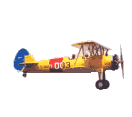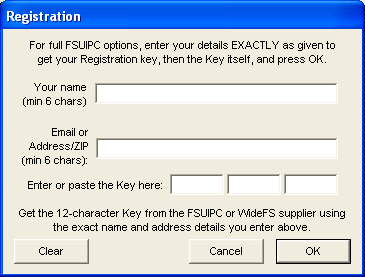
Thank you for your purchase of our Model 1010 Cessna
Avionics Panel with Magneto Test Feature. Before use, the Panel must be
programmed with switch assignments using a licensed version of FSUIPC.
The Switch Assignments are involved but can be easily assigned with
the help of the following information.
If you have any
comments or need additional information on the use of the 1010 Avionics
Panel,
please write us
at:
INSTALLATION
Installing the 1010D and the 1010E
Panel requires very little time. All you need is an unused USB Port. These
additional Ports can be added to your computer by using a device called a
USB Hub. These Hubs can be purchased for as little as $20.00 in the
Internet.
Just plus the USB Cables from
the back of the 1010D Panel into the Hub Adapter and let your computer
locate and load the required software for its proper operation. The Panel
will be sensed as "Avionics Panel 1010D". That's all there is to the
installation.
The 1010E and the 1010D Cessna Panels
are virtually the same panels except for the internal electronics and that
the 1010D has 4 RCA Jacks on the back while the 1010E has only 3. Except
for that, the instructions seen below can be used for
both.
Programming the
Toggle Switches
As mentioned earlier, the 1010D and
1010E does require the licensed version of FSUIPC. This small .dll program
resided inside the Module File of your FS2002, FS2004 or FS
X Flight Simulator. FSUIPC come is two versions. The FSUIPC 3.75 used
for FS98, FS2000, FS2002 and FS2004. While Version FSUIPC4 is used
strictly for the New FS X Flight Simulator.
Either one of these programs can be
Downloaded Free of charge from:
The Code Key for either program can
be purchased from simMarket (A link to simMarket is also provided at the
FSUIPC site). The code Key costs about $24.00.
When you download the required FSUIPC
program; copy the .dll program to Flight Simulator's "Module"
File. That's it. Now it's time to load and run your Flight Simulator
Program. When running, click on "Create a Flight". When you have a your
Cessna 172 or anyother aircraft on the Runway, press the "ALT" key. On the
TOP of the screen a thin white band of extra options will appear. Click on
"Modules"; then "FSUIPC".
Using FSUIPC for the first time, you
are asked to input your Name, Email Address and the Code Key you just
purchased. When entered correctly, FSUIPC is ready to be programmed for
use with your NAV/COM Radio (Note: After inputting your Code Key, you need
to Restart Flight Simulator so that the Code Key can take
effect.
After reloading your Flight
Simulator program; it's time to Program your NAV/COM
Radio.

Programming the 1010D
Switches
With your
copy of FSUIPC Registered; now is the time to program the Radio Panel.
Again, with FS running, hit the "ALT" Key. With the White Band appreaing
in the top of the monitor; click "Modules" then "FSUIPC". With the main
FSUIPC window showing, locate and click on "Buttons +
Switches".
You will
get the window appearing above.
There are three main
sections of this window that require our attention. They are indicated by
the letters "A", "B" and "C". Section "A" shows the Button or Switch that
you press and it's USB Port Location. By pressing other buttons on the
Radio Panel, these settings will change accordingly. "B" needs to be
click. The "Check" Mark needs to remain with ALL Programming. This Check
Mark allows you to choose your button assignments from the FSUIPC listing.
"C" shows all the assignments available that your 1010D Panel can be
programmed to.
Now using the TABLE
below, we will program each 1010D Switch and Push Button to the needed
functions. Table 1 shows the suggested setting of each of the 1010D's
switches. These are only suggestions, over time you will be familiar with
the FSUIPC settings and you will gain more confidence in programming the
1010D switches for your ouw needs.
Below is a photo of the
front panel of the 1010D's front Panel. Each Push Button, Toggle and
Rotary Key Switch is shown by a number. This number (in conjunction with
the information in the Settings Table) will show you the which button
would need to be "Flipped" or "Turned"
 Model 1010D's Button
Assignments for use with FSUIPC
Model 1010D's Button
Assignments for use with FSUIPC
With the Key Switch in its
"Magento Right" Position; start your version of
Flight Simulator. Open the FSUIPS software as discribed above and proceed
with the following TABLE.
|
Panel
Switch |
Switch
Action |
FSUIPC
Assignment |
| Key Switch |
Key Switch to
"OFF" |
MAGNETO OFF |
| Key Switch |
Key Switch to "R" |
MANGETO RIGHT |
| Key Switch |
Key Switch to "L" |
MAGNETO LEFT |
| Key Switch |
Key Switch to "BOTH" |
MAGNETO BOTH |
| Key Switch |
Key Switch to "START" |
MAGNETO START (
* CHECK - Control to REPEAT ) |
| Rocker SW #2 |
ALT/BAT On/Off |
TOGGLE MASTER BATTERY
ALTERNATOR |
| Toggle Sw #3 |
Fuel Pump On/Off |
TOGGLE ELECT FUEL PUMP |
| Toggle Sw #4 |
Land On/Off |
LANDING LIGHTS TOGGLE |
| Toggle Sw #5 |
Taxi Lights |
TOGGLE TAXI LIGHTS |
| Toggle Sw #6 |
Navigation Lights On/Off |
TOGGLE NAV LIGHTS |
| Toggle Sw #7 |
Beacon or Strobe Lights |
TOGGLE BEACON LIGHTS or (On-Screen Toggle Flips)
STROBES TOGGLE (On-Screen Toggle DOES NOT Flip) |
| Toggle Sw #8 |
Flip Pitot Heat Sw |
PITOT HEAT TOGGLE |
| Rocker Sw #9 |
Flip Avionics Master Sw |
TOGGLE AVIONICS
MASTER |
The
1010D also has 4 RCA Jacks available on the back panel (Model 1010E
only 3 RCA Jacks). This feature allows you to add additional
Push Buttons and/or
our Model 1070/2004 Parking Brake and the Carb Heat Controller to your Flight
Simulator.
Just plug in the device and program the
required Flight Function using FSUIPC or even
the available functions located within your
copy of MS2002, MS2004, FSX
(Settings then Assignment
pages).
HAPPY
FLYING!
Purchasing Information can be
found HERE;
| 








